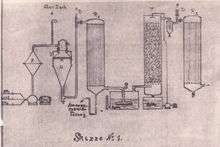Andrussow process

Late 1930: Semitechnical plant for experiments on the production of hydrogen cyanide with the Andrussow process in Herne, Germany, operated by Leonid Andrussow.

Diagram from 1931 showing the Andrussow process
The Andrussow process is an industrial process for the production of hydrogen cyanide from methane and ammonia in the presence of oxygen and a platinum catalyst.[1][2]
- CH4 + NH3 + 1.5 O2 → HCN + 3 H2O
The process is based on a reaction that was discovered by Leonid Andrussow in 1927. In the following years he developed the process that is named after him. HCN is also produced in the BMA process.
Side reactions
This reaction is very exothermic. The change of enthalpy of this reaction is equal to -481.06 kJ.[3] The heat provided by the main reaction serves as a catalyst for other side reactions.
- CH4 + H2O → CO + 3 H2
- 2 CH4 + 3 O2 → 2 CO + 4 H2O
- 4 NH3 + 3 O2 → 2 N2 + 6 H2O
These side reactions can be reduced by only short exposures to the catalyst of the order of 0.0003s.[4]
References
- ↑ Leonid Andrussow (1927). "Über die schnell verlaufenden katalytischen Prozesse in strömenden Gasen und die Ammoniak-Oxydation (V)". Berichte der deutschen chemischen Gesellschaft. 60 (8): 2005–2018. doi:10.1002/cber.19270600857.
- ↑ L. Andrussow (1935). "Über die katalytische Oxydation von Ammoniak-Methan-Gemischen zu Blausäure (The catalytic oxidation of ammonia-methane-mixtures to hydrogen cyanide)". Angewandte Chemie. 48 (37): 593–595. doi:10.1002/ange.19350483702.
- ↑ Deák, Gyula (1980), Menné reakcie v organickej chémii, Bratislava: Vydavateľstvo technickej a ekonomickej literatúry, p. 14
- ↑ Pirie, J M (1958). "The Manufacture of Hydrocyanic Acid by the Andrussow Process" (PDF). Platinum Metals Rev. 2 (1): 7–11. Retrieved 28 March 2014.
This article is issued from Wikipedia - version of the 6/29/2016. The text is available under the Creative Commons Attribution/Share Alike but additional terms may apply for the media files.